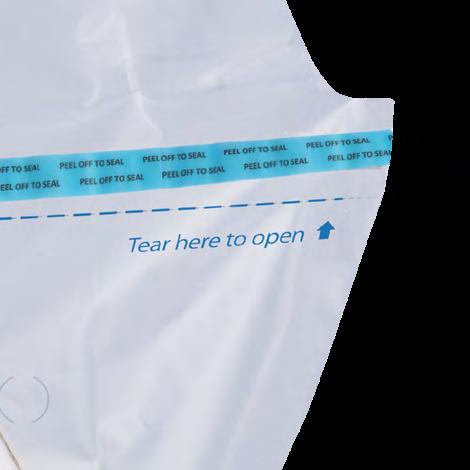
3 minute read
Bagging Techniques
by novolex
What you put in your bag matters
1 2 3
Build sides with any item except for crushable items. Fill the bottom of the bag by utilizing any available space. Place lighter items on top of the bottom layer.
Plan The Order
◾ A good bagger looks over the size of the order and plans the load.
Build Up The Walls
◾ Make a trim square bag, placing flat packages on the side of the sack, which builds up the walls, and gives the bag stability. ◾ Building up the walls also makes the bag easier to carry and forms a protective center (funnel) for breakable goods.
Place Small, Breakable Items In The Center
◾ Keep glass bottles and jars off the top of the bag. ◾ Put glass bottles and jars in the center (funnel) to ensure their protection. ◾ Always tighten caps on bottles before they are placed in the bag.
Pack It Solid
◾ Fill in gaps with small merchandise. ◾ A solid pack prevents shifting and cuts down on breakage.
Open The Bag Quickly
◾ Open the bag by putting both hands down through the center and squaring the bottom.
Split The Order For Equal Weight
◾ Don’t overload the bag by putting the bulk of heavy merchandise in one bag. ◾ Balance the load by placing heavy items in two or three bags, the customer will appreciate this gesture, especially if the merchandise has to be carried up a flight of stairs. ◾ Heavy items should always be double bagged. Avoid bagging where appropriate – see special handling section. Crushables
◾ Place crushables in a separate bag or on top of more solid, non-breakable items. ◾ Eggs, potato chips, soft fruits and vegetables, light bulbs, and bakery goods should be placed on top where they are free from pressure. ◾ Or place the crushables together in a separate plastic bag.
Build A Solid Foundation
◾ Build a square foundation and distribute the weight in the center of the bag by placing small cans, glass jars and other items in it. ◾ This strong base helps the bag to stand upright and makes it easier to carry. From this point, continue to build your load from heavy to light. ◾ Notice the word “place.” Never throw items into the bag. ◾ Place the items with grace and speed, but never throw them.
Special Handling!
◾ Ammonia, bleach and other chemicals should not be placed with food items. ◾ The residue on these items will contaminate the food. Avoid danger by double bagging these items separately. ◾ Don’t bag large heavy items such as gallons of milk, gallons of bleach, gallons of water, sacks of vegetables, frozen turkeys, pet foods, laundry detergents, cases of soda and items with built in handles or carry assist capabilities.
CAUTION
In order to avoid bag failure and potentially serious injury to person or property, at all times and for all interactions with the bags, please follow the below instructions: • Maintain the integrity and structure of the bag, and prevent any scrapes, tears, abrasions, or holes; particularly when using bags along counters, in buggies, and against the consumer’s goods. • Never overload the bag with excess weight or with goods that may cause the bag to fail. • Always use reasonable good judgment when packing bags with goods, and double bag the goods for extra protection or where necessary to avoid overload failure or goods that may cause the bag to fail, or as a last resort avoid bagging the goods altogether and place goods directly into the consumer’s cart. Sample Goods to Consider for Double Bagging: • Metal Canned Goods • Glass Bottles, Containers, or Jars • Heavyweight Goods with unique or sharp edges or corners • Any Goods with unique or sharp edges or corners. When double bagging is warranted, the bagged merchandise should be picked up using all four bag handles. Sample Goods to Consider to Avoid Bagging and for Placing Directly into Consumer’s cart: • Milk • Two Liter Containers • Large Wine Bottles • Large Canned Goods • Laundry Detergent • Frozen Turkeys • Any Goods with Built in Handles or Carry Assist Capabilities. Use extra caution at all times when bagging goods and always use reasonable good judgment to avoid bag failure and potentially serious injury to person or property.









